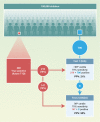Birth and coming of age of islet autoantibodies
- PMID: 31397889
- PMCID: PMC6857083
- DOI: 10.1111/cei.13360
Birth and coming of age of islet autoantibodies
Abstract
This review takes the reader through 45 years of islet autoantibody research, from the discovery of islet-cell antibodies in 1974 to today's population-based screening for presymptomatic early-stage type 1 diabetes. The review emphasizes the current practical value of, and factors to be considered in, the measurement of islet autoantibodies.
Keywords: Autoantibodies; ICA; Islet-cell antibodies; Type 1 diabetes.
© 2019 The Authors. Clinical & Experimental Immunology published by John Wiley & Sons Ltd on behalf of British Society for Immunology.
Figures


References
-
- Gepts W. Pathologic anatomy of the pancreas in juvenile diabetes mellitus. Diabetes 1965; 14:619–33. - PubMed
-
- Cudworth AG, Woodrow JC. HL‐A antigens and diabetes mellitus [Letter]. Lancet 1974; 2:1153. - PubMed
-
- Strosberg JM, Harris ED Jr. Letter: HL‐A genotypes and diabetes. Lancet 1974; 2:1212. - PubMed
-
- Menser MA, Forrest JM, Honeyman MC, Burgess JA. Diabetes, HL‐A antigens, and congenital rubella [Letter]. Lancet 1974; 2:1508–9. - PubMed
Publication types
MeSH terms
Substances
LinkOut - more resources
Full Text Sources
Miscellaneous

